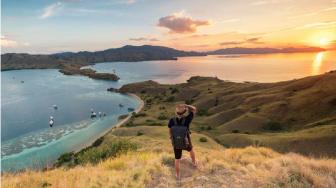
Jokowi Launched Ben Mboi Hospital, The Largest in Eastern Indonesia
The hospital built with a budget of around US$27 million has complete health facilities.

The hospital built with a budget of around US$27 million has complete health facilities.

Indonesia expects to receive at least 7.4 million international arrivals to produce a $ 6 billion exchange following the spike in foreign tourists last year.

Sandiaga Uno said his office is still deliberating the rule to re-allow visitors to climb up the Borobudur Temple in Magelang, Central Java.

TheIndonesia.id - The polemic over the hiked entrance fee to Komodo Island surfaced over the past few days after President Joko Widodo (Jokowi) visited Labuan Bajo in West Manggarai, East Nusa Tenggara (NTB), on July 21-22 2022. The government plans to apply the new entrance fee of Rp3.75 million per ticket holder to visit Komodo Island and Padar Island, starting August 1, 2022, for a year.
So far, the entrance fee to Komodo National Park was around Rp200 thousand. The government decided to increase the entrance fee to compensate for the damage to the Komodo National Park ecosystem and as a conservation measure. The entrance fee hike aimed to limit the number of tourists visiting Komodo National Park to 200 thousand visitors per year.
Without placing a cap on the number of visitors, the Komodo National Park Office has forecasted the number of visitors at Komodo National Park to reach 300 thousand in 2030 and 480 thousand in 2045. Hence, the government decided to limit the number of visitors before the figure peaked.
A study conducted by the Komodo National Park Office recommended the ideal number of visitors to Komodo National Park was only 219 thousand per year, or a maximum of 292 thousand visitors per year.
However, the ideal figure was never realized. Based on the data of visits, in 2014, the number of tourists that visited the Komodo National Park was below 100 thousand and jumped to 200 thousand in 2019. In 2020, the figure had dropped to less than 50 thousand due to the COVID-19 pandemic. If the pandemic subsided, the number of visits was expected to increase.
Based on the implementation of intensive monitoring activities by the Komodo National Park rangers and researchers at the Komodo Survival Program Foundation, the Komodo dragon population was known to be more than 2,897 in 2018, over 3,022 in 2019, and 3,163 in 2020, and more than 3,303 in 2021.
The plan to increase the entrance fee for Komodo National Park has drawn a negative response from tourism entrepreneurs. The plan is considered to be detrimental to the area's tourism sector, as the local community depends on income as tourist business owners.
Some 12 tourism associations that voted against the tariff hike comprised the Association of Indonesian Travel Companies (ASITA), Tourism Boat Association (Askawi), Indonesian Hotel and Restaurant Association (PHRI), the Indonesian Tourist Guides Association (HPI), the Land Tourism Transportation Association (Awstar), the Tourism Rescue Community Forum (Formapp), Astindo, Indonesian Tourism Personnel (IPI), Komodo Dive Operators Community (DOCK), Recreational Boat Network (Jangkar), the Labuan Bajo Entrepreneurs Association (BPLB), and the Association of Unitas Business Groups (Akunitas).
They noted that only the upper middle class could afford the entrance fee of Rp3.75 million. Hence, the entrance fee hike would have a negative impact on the number of tourist visits. Another impact was booking cancellations by prospective clients of travel agents in the area.
From the business owners' perspective, their response was understandable since they focused on bringing more tourists to gain more profits for them.
However, apart from tourism, conservation was also necessary for the Komodo National Park and the surrounding areas. Human activity was noted as being one of the causes of environmental damage in various regions, including in several areas used as tourism objects. All related parties, including tourists and tourism agents, should understand this condition. Moreover, funding for conservation could not be fully supported by the state.
Hence, financing for conservation could come from tourist activities. This emphasized that tourism development was important since the funds generated could support the need for funds for maintenance. In several areas, tourism played an important role in raising funds for conservation, which means tourism and conversion could go hand in hand and not separate.
President’s Decision
Based on the premise above, President Jokowi took a firm decision to support the policy of increasing the entrance fee for Komodo National Park to Rp3.75 million in Komodo Island and Padar Island, effective since August 1, as an effort to preserve the conservation area and to support continued growth of the economy through tourist visits.
Tourists refusing to pay the amount are suggested to visit Rinca Island where a more affordable entrance fee is offered, and they can still see Komodo dragons.
“Tourists can also go to Rinca Island to see the Komodo dragon. The entrance fee remains the same, with no increase,” Jokowi stated.
Jokowi’s statement has shown that tourism and conservation must go hand in hand. If the government is keen to focus more on conservation, then the Komodo National Park could be closed for tourism and open only for research or other scientific activities.
Learning from the case of Komodo Island, the government should set a standard in other tourist areas to harmonize tourism and conservation. For instance, in some cities, hilltop tours are currently popular owing to the panoramic views of the city from a height. The problem arose when more hills were abruptly converted into tourist destinations while neglecting the nature conservation aspect.
It is not too late for the government to apply standardization to hill tourism business since nature should not be sacrificed for the sake of tourism. (Antara)